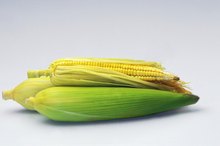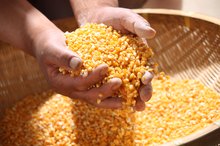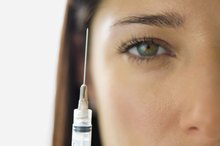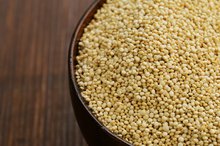What does fact checked mean?
At Healthfully, we strive to deliver objective content that is accurate and up-to-date. Our team periodically reviews articles in order to ensure content quality. The sources cited below consist of evidence from peer-reviewed journals, prominent medical organizations, academic associations, and government data.
The information contained on this site is for informational purposes only, and should not be used as a substitute for the advice of a professional health care provider. Please check with the appropriate physician regarding health questions and concerns. Although we strive to deliver accurate and up-to-date information, no guarantee to that effect is made.
An allergic reaction to corn in the United States is extremely low, with an estimated prevalence of 0.016 percent in the general population, according to the Corn Refiner's Association. The symptoms of an allergic reaction to corn are similar to other food allergies, with skin inflammation and dermatitis commonly cited in sensitized individuals.
If you are experiencing serious medical symptoms, seek emergency treatment immediately.
Immunologic Response to Corn
An allergic reaction to corn occurs when the immune system mistakenly identifies the lipid proteins in corn as foreign and dangerous. The immune system mounts an IgE mediated attack against the lipid proteins, and activates and mobilizes pro-inflammatory cells to the inflammation site. These immune cells, primarily basophils and mast cells, perpetuate the immune response by releasing histamine into the bloodstream and surface of the skin. Histamine dilates and increases blood vessels, allowing fluids to move to the surface of the skin. It also increases the contraction of smooth muscles in the upper respiratory tract, and digestive tract.
- An allergic reaction to corn occurs when the immune system mistakenly identifies the lipid proteins in corn as foreign and dangerous.
- These immune cells, primarily basophils and mast cells, perpetuate the immune response by releasing histamine into the bloodstream and surface of the skin.
Skin Rash
Corn Allergies & Acne
Learn More
The release of histamine dilates and increases the permeability of blood vessels and capillaries, thereby allowing fluids and toxins to move to the surface of the skin. A skin rash involved with hives can appear anywhere on the body. The hives are typically red, itchy and raised with a pale center, and can migrate throughout the body. Hives and the accompanied swelling typically appears within 24 hours of ingesting corn or corn derived products. Atopic dermatitis, also known as eczema, is another skin rash commonly observed during an allergic reaction to corn. The skin eventually becomes cracked and thickened because of the scratching and itching.
- The release of histamine dilates and increases the permeability of blood vessels and capillaries, thereby allowing fluids and toxins to move to the surface of the skin.
- A skin rash involved with hives can appear anywhere on the body.
Treatment of an Allergic Skin Reaction to Corn
The most effective treatment for corn allergy is avoiding corn or corn-derived products 2. A corn-free diet requires the elimination of corn flour, corn starch, cornmeal and corn. If you accidentally ingest corn and develop an allergic skin reaction, you may not need treatment if the symptoms are mild. Over the counter corticosteroids, such as:
- hydrocortisone
- as well as second generation antihistamines
- including Zyrtec
- are effective in reducing the inflammation
- itching
- The most effective treatment for corn allergy is avoiding corn or corn-derived products 2.
Testing for an Allergic Skin Reaction
Corn Allergy and Eczema
Learn More
Due to the scarcity of an allergic reaction to corn, your physician may need to perform an allergy test 2. A skin test may be given by your physician to ensure correct diagnosis. You will be injected with a small amount of the lipid protein from corn on your forearm or upper arm. After a period of 15 to 20 minutes, your physician will be able to determine if you are allergic to corn based on if whether or not you have swelling, redness or develop hives at the injection. A blood test may also be conducted to determine the level of circulating IgE antibodies in response to corn. A provocation test in which you are given corn or corn-derived products under medical supervision may be used to provoke an allergic reaction. These tests should only be performed by a physician.
- Due to the scarcity of an allergic reaction to corn, your physician may need to perform an allergy test 2.
- A provocation test in which you are given corn or corn-derived products under medical supervision may be used to provoke an allergic reaction.
Related Articles
References
- Corn Refiners Association; Allergens; October 2006
- Children's Hospital of The King's Daughters: Corn Allergy
- MedlinePlus; Allergy Testing; June 2011
- Corn, sweet, yellow, raw. FoodData Central. U.S. Department of Agriculture. Published April 1, 2019.
- Choosing good carbs with the glycemic index. Harvard Health Publishing, Harvard Medical School. Updated 2012.
- Corn. Grains & Legumes Nutrition Council. Updated 2020.
- Luna-Vital DA, Gonzalez de Mejia E. Anthocyanins from purple corn activate free fatty acid-receptor 1 and glucokinase enhancing in vitro insulin secretion and hepatic glucose uptake. PLoS ONE. 2018;13(7):e0200449. doi:10.1371/journal.pone.0200449
- Harvesting the health benefits from corn. Tufts University Gerald J. and Dorothy R. Friedman School of Nutrition Science and Policy. Updated 2013.
- Njike VY, Smith TM, Shuval O, et al. Snack food, satiety, and weight. Adv Nutr. 2016;7(5):866-78. doi:10.3945/an.115.009340
- Popcorn, air-popped, unbuttered. USDA FoodData Central. April 1, 2020
- Vitamin A: Fact Sheets for Health Professionals. National Institutes of Health, Office of Dietary Supplements. Updated 2020.
- Magnesium: Fact Sheets for Health Professionals. National Institutes of Health, Office of Dietary Supplements. Updated 2020.
- Corn Allergy. American College of Allergy Asthma & Immunology. Updated 2019.
- Corn. Non-GMO Project. Updated 2016.
- GMO Crops, Animal Food, and Beyond. U.S. Food and Drug Administration. Updated 03/04/2020
- High Fructose Corn Syrup Questions and Answers. U.S. Food and Drug Administration. Updated 2018.
- Bray GA. Energy and fructose from beverages sweetened with sugar or high-fructose corn syrup pose a health risk for some people. Adv Nutr. 2013;4(2):220-5. doi:10.3945/an.112.002816
- Different types of corn. The Popcorn Board. Updated 2020.
- Corn. USDA SNAP-Ed Connection.
- Corn. Grains & Legumes Nutrition Council. Updated 2020.
- Sweet Corn. Purdue Extension FoodLink. Updated 2014.
Resources
Writer Bio
Danielle Stevens is a graduate of George Washington School of Medicine and is currently a resident fellow at Georgetown University Hospital. Stevens is interested in pediatrics and gynecology as well as pediatric surgery. Stevens has been writing professionally since 2008 for The American College of Obstetricians and Gynecologists, Words and Numbers, and Prime Inc.









